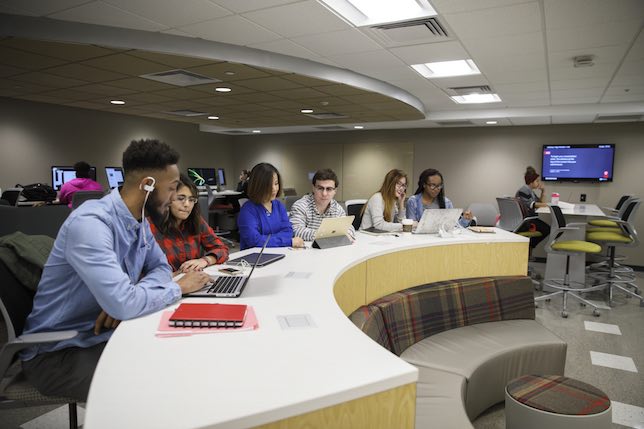The Power of the Consortium in Higher Education
A Q&A with Stacy Morrone
Often we hear about consortia and other co-op efforts formed for the purposes of gaining pricing advantage for their membership on a multi-institution or even a statewide basis. These organizations do provide a valuable service. But many consortia in higher education go much farther in creating new opportunities for their communities. Here, CT talks with Indiana University's AVP for Learning Technologies Anastasia Morrone about the impact of consortia in higher education.
"Sometimes our conversations are practical. Sometimes they are visionary. But we are creating a thriving community that works in the best interests of higher education." — Stacy Morrone
Mary Grush: You've worked with the Big Ten Academic Alliance, the Unizin consortium, and other multi-institution collaboratives. These groups are far more than co-ops for purchasing advantage. In your experience, what is the real appeal of consortia or alliances for higher education?
Stacy Morrone: For me, the power of these kinds of organizations is that they allow like-minded institutions and people to come together to try to solve issues facing higher education — by connecting across institutions to get ideas outside of our own university and working together on some type of initiative, activity, or service that will meet the needs of all of us. So for me, the focus moves from what's happening at Indiana University to what's happening with our peer institutions and how we can work together to move along more quickly than we ever could if we were trying to do everything ourselves.
Another important point is that we control our destiny in a way that is appealing to us. There are a lot of companies that have very good products and want to work with us. But sometimes there is a solution we want that is really for us — rather than something that a vendor has decided is right for us. We think through problems or issues in higher education and come together to figure out how to best move forward.

Students collaborate in active learning spaces at IU. Technology drives engagement in these spaces, bringing students together to learn from and inspire one another. Consortia and alliances are key for IU and other institutional members because they not only increase access to this technology, but also help guide future directions and development to increase student success. (Photo courtesy Indiana University)
Grush: Does that mean that consortia develop their own products?
Morrone: The Unizin consortium is a good model to answer your question. Sometimes we develop products ourselves, through our members or consortium staff. Other times we license vendor products that can meet the needs we have, and make them available to consortium members.
But what is really important is that we have the ability to come together and say, "Here are some pressing problems — what do we need to solve them?"
Grush: You mention "like-minded" institutions. That is a generality, of course. How do similar needs make the consortial efforts work?
Morrone: For IU, the Big Ten Academic Alliance is of course comprised of our peer institutions. We have many similarities, and some differences, too. One thing that is particularly effective for us, is that there are several groups within the Big Ten Academic Alliance. The Learning Technology Leaders group, for example, is made up of peers of mine, who are at other Big Ten institutions. Individual members have a lot in common with others in groups like this, and so we enjoy the opportunity to work together in depth on the common problems we are facing.
Grush: How do consortia and alliances come about, initially?
Morrone: In the case of Unizin, which was formed in 2014, four institutions came together because we were realizing that we were all thinking about digital education and how we could improve student success, affordability, increased access… all the things that all of us were thinking about all the time. And there were already established, excellent partnerships among this group of four founding institutions: University of Michigan, University of Florida, Colorado State University, and Indiana University.
It was really the Chief Information Officers who identified the opportunity to establish a consortium that would create a new digital learning ecosystem to serve the common needs of our original four institutions, around data, content and OERs, learning analytics, and a shared learning management system… And so we formed Unizin, which now has a membership of more than two dozen institutions, including institutions in two state systems.
Grush: And does Unizin help ensure that institutions will have standardized data and platforms?
Morrone: Yes, certainly. The learning management system is an example of that. If every institution is using a different learning management system, it makes it much harder to offer a common experience and create an interoperable infrastructure. We needed to standardize on the LMS to have what James Hilton at the University of Michigan has called "common gauge rails". Canvas by Instructure was the LMS we chose for Unizin.
Grush: Can size increase the consortium's effectiveness?
Morrone: Yes, it can. In the case of Unizin, it's exciting to see the variety of institutions coming in through the state systems to contribute to the conversation of what we need to do in higher education. These voices — of people in all different roles within their own institutions, from academics, to librarians, to top-level administrators — inform the work of the consortium.
Think about this, too: As we grow, we can create data sets that can be put in the Unizin data platform, to support learning analytics and student success. In a sense, we can create the world's largest learning research laboratory!
Grush: So, consortia not only help institutions acquire cost-effective resources and access to standardized technologies — they give their members a chance to work on important issues and influence change for higher education.
Morrone: Yes! Sometimes our conversations are practical. Sometimes they are visionary. But we are creating a thriving community that works in the best interests of higher education.

IU students on the Bloomington campus (Courtesy Indiana University)